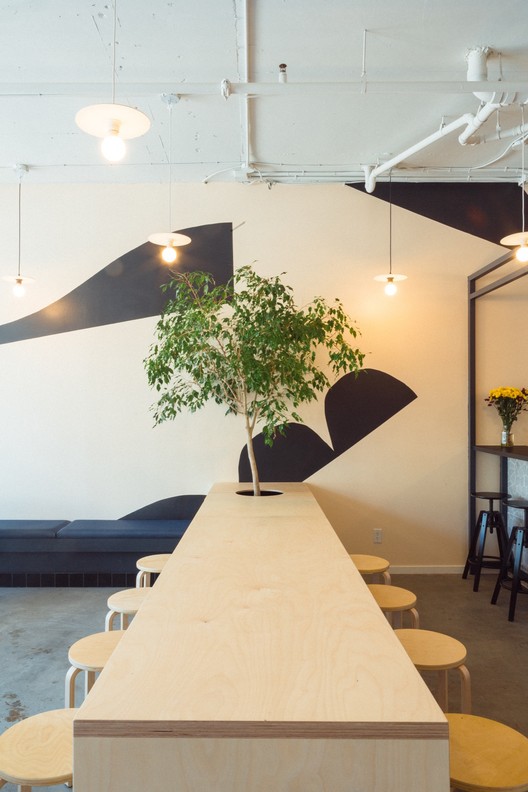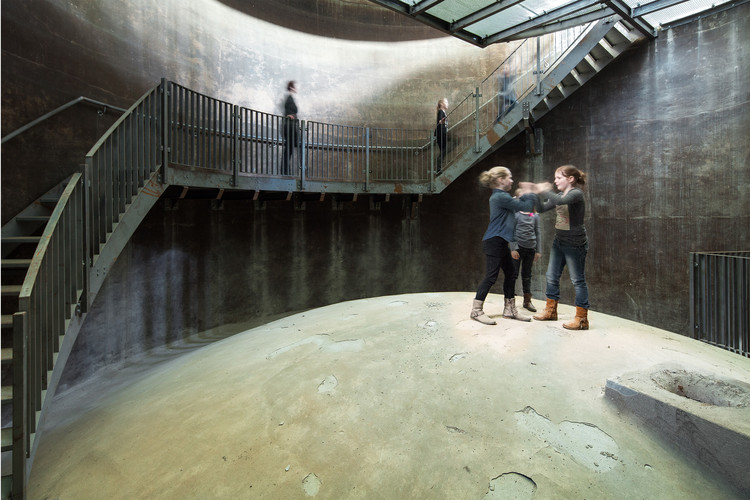Automobile Design Studio SJK Architects
2015-08-25 18:00
架构师提供的文本描述。几十年来,Mahindra和Mahindra一直是印度农场和多功能汽车的市场领先者,自从进入商用汽车市场以来,这两家公司就家喻户晓。从威利斯吉普到天蝎座,以及最近的XUV 500,他们推出了非常受欢迎的汽车,在最近几年里,这些车给这个品牌带来了健壮、坚固、阳刚和可靠的美誉。
Text description provided by the architects. Mahindra and Mahindra has been a market leader in farm and utility vehicles in India for several decades and a household name more recently since they launched into commercial vehicles. From the Willys Jeep to the Scorpio and the more recent XUV500, they have delivered outstandingly popular vehicles that have given the brand a reputation for being robust, rugged, masculine, and dependable, in the recent few years, stylish.
Mahindra和Mahindra接近我们创建了一个先进的设计工作室,在那里他们将设计他们的最新车辆。工作室将是设计师的领域,在公司中拥有特殊的地位和地位,公司的高层管理人员和他们的国际合作者经常光顾该工作室。这份简报描述了工作室需要有一种“压倒性的设计感”,一种“情绪化”的品质,可以“激励和激发思想”,随着时间的推移而“进化”,并感觉到“真实的”它的起源。
Mahindra and Mahindra approached us to create a cutting edge design studio, where they would style their newest vehicles. The studio would be the designer’s domain, holding special status and pride of place in the company, and frequented by the company’s top management as well as by their international collaborators. The brief described the need for the studio to have an ‘overwhelming sense of design’, an ‘emotive’ quality that could ‘energize and inspire thoughts’, ‘evolve’ with time and feel ‘true to its origins.
The site identified for the design studio was within their 64 acre M&M factory campus in Kandivili, with its low-lying sheds and lush greenery - an oasis, reminiscent of Mumbai of the bygone decades, amidst the concrete jungle surrounding it. It is perhaps the last of industrial campuses that occupied land on the highway of what was previously the outskirts of a fast growing city.
该遗址由5个现有的棚屋组成,面积共计25,000平方英尺,与其他类似的相邻棚屋相依为命。因此,该遗址的特点是明显的“工业”;这些建筑不是最新的、唾沫和抛光的预制钢类型,而是使用手工工具制造的旧建筑-使用标准轧制的钢材在现场制造、焊接和固定,在大部分建筑上完全相同,但由于手工制造而产生的异常和不完美之处也是相同的。
The site consisted of 5 existing sheds, totally 25,000 square-feet in size, nestled amongst other similar looking contiguous sheds. The character of the site was, thus, distinctly ‘industrial’; the buildings were not the latest, spit and polish, prefabricated steel types, but their older counterparts – made with hand-held tools using standard rolled steel sections that were fabricated, welded and bolted at site to create the buildings, identical for most part but with the anomalies and imperfections that arise out of being handmade.
我们吸收了场地、环境和品牌特性的影响,概念化了一个使用自然光的崎岖原始空间,庆祝它的工业和金属环境,并以一个中性的具体背景来赞美它。中立是很重要的,因为赛车和它的造型是最终的主角在空间-工作室必须是背景,而不是竞争!用于门、屏风等的金属片。受到广泛使用的材料在汽车工业的启发,并进一步推动孟买的丰富传统的金属作品。
We assimilated the influences of site, context and brand identity to conceptualise a rugged, raw space that used natural light, celebrates its industrial and metallic context and compliments it with a neutral concrete backdrop. Neutrality was important, since the car and its styling are the ultimate protagonist in the space - the studio has to be the backdrop and not the competition! The use of metal sheets for doors, screens etc. was inspired by the extensive use of the material in the automobile industry and further impelled by Mumbai’s rich tradition of metal works.
当我们在现场开始施工时,这些建筑物被拆除,露出了结构体系,结构体系保留了所有的缺陷,并得到了加强。当我们增加新的墙壁和其他设计元素时,我们允许庆祝结构体系,让它成为可见的,并确保新的设计与之相适应;每个设计都发挥了自己诚实的作用-现有的结构体系使空间扎根于它的起源,而新的设计层属于“现在”(Now)。
As we started work at site, the buildings were stripped down to bare the structural system which was retained with all its imperfections, and strengthened. As we added new walls and other elements of design, we allowed the structural system to be celebrated, leaving it visible and ensuring that the new design adapts to it; each played its own honest role – the existing structural system grounding the space to its origins, and the new design layers belonging to the ‘now’.
当我们把旧的和新的缝合在一起时,工作室需要“进化”和“忠于它的起源”,这影响了对项目的材料和细节的处理。我们试图使用所有的新材料,混凝土和石膏墙壁和金属‘生’-以诚实,裸露和裸露的形式。这被证明是具有挑战性的-每一步都必须计划和排练,因为每一次划痕、凹痕或难看的焊接都会被所有人看到。我们使用的每一种金属-球状钢、软钢、不锈钢和半金属-在其原始状态下都有自己的特点,就像管弦乐队一样对故事做出了贡献。
As we stitched the old and new together, the need for the studio to ‘evolve’ and ‘be true to its origins’ influenced the treatment to material and detail of the project. We attempted to use all new materials, concrete and plaster for walls and metals ‘raw’ - in an honest, exposed and bare format. This proved to be challenging - every step had to be planned and rehearsed, for every scratch, dent or unsightly weld would be visible for all to see. Each metal that we used- corten steel, mild steel, stainless steel and galvalume, in its raw state holds its own and contributes to the story like an orchestra.
工业建筑的工艺是我们吸取的历史和技术,以适应“平凡”的棚到一个尖端的设计工作室。我们认为,适应重用的挑战是保持历史的活力,同时发展一个当代、舒适和富有诗意的“今天”。
The craft of industrial buildings is the history and skill we have drawn on to adapt “mundane” sheds into a cutting edge design studio. The endeavour, which we see as the challenge to adaptive reuse is to keep history alive while evolving a “today’’ that is contemporary, comfortable and poetic.
 举报
举报
别默默的看了,快登录帮我评论一下吧!:)
注册
登录
更多评论
相关文章
-

描边风设计中,最容易犯的8种问题分析
2018年走过了四分之一,LOGO设计趋势也清晰了LOGO设计
-

描边风设计中,最容易犯的8种问题分析
2018年走过了四分之一,LOGO设计趋势也清晰了LOGO设计
-

描边风设计中,最容易犯的8种问题分析
2018年走过了四分之一,LOGO设计趋势也清晰了LOGO设计












































































